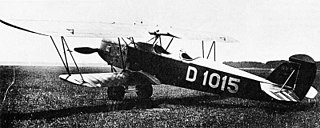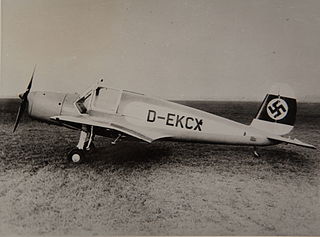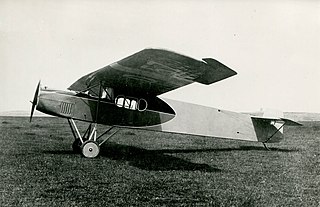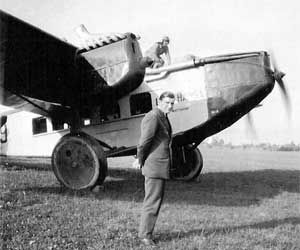Related Research Articles

The Arado Ar 234 Blitz is a jet-powered bomber designed and produced by the German aircraft manufacturer Arado. It was the world's first operational turbojet-powered bomber, seeing service during the final years of Second World War.

The Arado Ar 196 was a shipboard reconnaissance low-wing monoplane aircraft designed and produced by the German aircraft manufacturer Arado. It was the standard observation floatplane of the Kriegsmarine throughout the Second World War, and was the only German seaplane to serve throughout the conflict.

The Arado Ar 68 was a single-seat biplane fighter designed and produced by the German aircraft manufacturer Arado Flugzeugwerke. It was among the first fighters produced when Germany abandoned the restrictions of the Treaty of Versailles and began rearming.

The Arado Ar 232 Tausendfüßler, sometimes also called Tatzelwurm, was a cargo aircraft, designed and built in small numbers by the German firm Arado Flugzeugwerke during World War II. The design introduced, or brought together, almost all of the features now considered to be standard in modern cargo transport aircraft designs, including a box-like fuselage slung beneath a high wing; a rear loading ramp ; a high-mounted twin tail for easy access to the hold; and various features for operating from rough fields. Although the Luftwaffe was interested in replacing or supplementing its fleet of outdated Junkers Ju 52/3m transports, it had an abundance of types in production at the time, and did not purchase large numbers of the Ar 232.

The Arado Ar 64 was a single-seat biplane fighter designed and produced by the German aircraft manufacturer Arado. It was among the first fighters produced when Germany abandoned the restrictions of the Treaty of Versailles and began rearming.

The Arado Ar 65 was the single-seat biplane fighter successor to the Ar 64. Both looked very similar. The only major difference was the use of a 12-cylinder inline engine versus the Ar 64's radial. The wingspan was also increased.

The Arado Ar 96 is a single-engine, low-wing monoplane of all-metal construction, designed and produced by the German aircraft manufacturer Arado Flugzeugwerke. It was the Luftwaffe's standard advanced trainer throughout the Second World War.

The Albatros L 75 Ass was a German trainer biplane of the 1920s. Of conventional configuration, it seated the pilot and instructor in separate, open cockpits. The wings were single-bay, equal-span, and had a slight stagger. Production continued after Albatros was absorbed by Focke-Wulf.

The Arado Ar 95 was a single-engine reconnaissance and patrol biplane designed and produced by the German aircraft manufacturer Arado.

The Arado S I was a biplane trainer built in Germany in 1925. The first of three prototypes was powered by a Bristol Lucifer radial engine, while the other two Arado S.Ia aircraft were fitted with the Siemens-Halske Sh 12. The Siemens-Halske Sh 11 powered the Arado S III, a virtually identical aircraft of which only a single prototype was constructed and sold to Turkey.

The Arado SC I was a biplane trainer developed in Germany in the 1920s. It was based on the S I, but powered by a far more powerful inline engine. Accordingly, the structure received considerable strengthening. The aircraft was intended for the clandestine military flying school at Lipetsk, but it was not accepted for this service. Instead, a small number were built for the Deutsche Verkehrsfliegerschule.
The Arado V.1 was a prototype airliner, built in Germany in 1927. It was a single-engine, high-wing braced monoplane with tailwheel undercarriage. It made several long-distance flights, including carrying mail to South America, before being exhibited in Berlin in 1929, when it was bought by Deutsche Luft Hansa.
The Arado W 2 was a two-seat twin-engine seaplane trainer developed for the DVS in 1928. It was a cantilever monoplane with a fabric-covered steel tube fuselage that accommodated the pilot and instructor in tandem open cockpits. The undercarriage consisted of two pontoons carried on steel struts.

The Arado Ar 79 was an aerobatic two-seat trainer and touring aircraft designed and produced by the German aircraft manufacturer Arado. It was the final civilian aircraft developed by the company.

The Fokker F.II was the first of a long series of commercial aircraft from the Fokker Aircraft Company, flying in 1919. In a biplane age, it presented a distinct clean, high-wing monoplane style that sold successfully across Europe and North America during the development of commercial passenger-carrying aviation.

The Rohrbach Ro VIII Roland was an airliner produced in Germany during the 1920s. It was a conventional strut-braced, high-wing monoplane, based loosely on the Zeppelin-Staaken E-4/20 that Adolf Rohrbach designed in 1920. It had a fully enclosed flight deck and passenger cabin, and featured fixed, tailskid undercarriage. Power was supplied by three engines, one in the nose, and two mounted in nacelles on the wings. Construction was of metal throughout.

The Arado E.381 was a proposed parasite fighter aircraft. Conceived by Arado Flugzeugwerke in December 1944 for Germany's Luftwaffe during World War II, the E.381 was to have been carried aloft by and launched from an Arado Ar 234 "mother" aircraft. It would then have activated its rocket engine, which would have propelled it to attack Allied bombers. Development was cancelled due to lack of funds and official support.

The Arado Ar 198 was a prototype reconnaissance aircraft, developed by Arado Flugzeugwerke, with backing from the Luftwaffe, who initially preferred it over the Blohm & Voss BV 141 and the Focke-Wulf Fw 189. However, when flight tests were carried out the aircraft performed poorly and did not impress the Luftwaffe. One aircraft was completed in 1938.
The Arado Ar 69 was a two-seat German beginner's school and sport biplane with an open cockpit, developed in 1933 by Arado Flugzeugwerke.

The LFG V 60 was a small, single engine, tandem seat floatplane training aircraft, designed and built in Germany in the mid-1920s. About five were constructed.
References
Citations
Bibliography
- Grey, C.G., ed. (1928). Jane's all the World's Aircraft 1928. London, UK: Sampson Low, Marston & company, ltd. p. 129c.
- Kranzhoff, Jörg Armin (1997). Arado, History of an Aircraft Company. Atglen, Pennsylvania, US: Schiffer Books. ISBN 0-7643-0293-0.